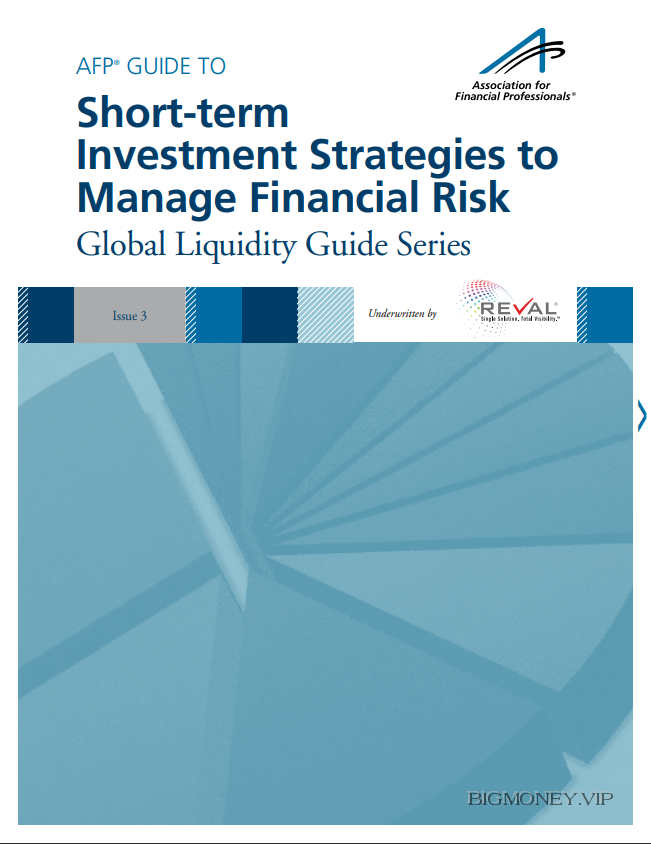Global Liquidity Guide Series: Short-term Investment Strategies to Manage Financial Risk

Introduction
This paper is intended to give the reader the tools to
develop an investment strategy for managing global
cash and the associated financial risks. In this paper,
short-term is defined as any period up to one year.
There are a number of common scenarios in which an
investment decision is required. These include:
■ the investment of overnight surplus cash;
■ the investment of general working capital;
■ the investment of funds set aside for a particular
purpose (e.g. to fund an acquisition or to return to
shareholders); and
■ the investment of funds received from a recent
divestment.
At first sight, all these circumstances appear to suggest
different investment strategies. The nature of the
cash being invested is different, the timescales are
different and the level of risk an organization might
be prepared to accept may be different.
Yet it is possible, indeed desirable, to approach each
investment decision with a single strategy. Having a
single short-term investment policy, irrespective of
the investment circumstances, will allow the treasury
team responsible for investing cash to manage the
investment risk in a consistent manner.
Today’s strategic treasurers understand that all short-
term investment decisions are fundamentally about
managing risk. In every case, the cash to be invested
over the short term must be placed somewhere. This
may be ‘idle’ in the company’s checking account,
swept to a money market account or overnight
deposit account, or invested in a range of short-term
investment instruments. Whatever the decision made,
the treasurer will need to have a clear understanding
of the fundamental objectives of investing:
maintaining principal, ensuring liquidity, and
maximizing yield. The treasurer must also recognize
that, just as there will be risks when choosing to
invest in particular instruments, so there are risks in
choosing (whether actively or passively) to keep cash
wherever it happens to be.
“All short-term investment
decisions are fundamentally
about managing risk.”
Setting and Implementing
Investment Strategies
The treasurer can work together with the CFO
with, in many instances, the board’s prior approval,
to develop a short-term investment strategy, an
investment policy and a set of operating procedures.
The treasurer will be best placed to drive this process,
given that the primary focus of any short-term
investment strategy should be to manage risk in the
context of the company’s risk appetite.
The Strategy-Setting Process
The first stage will be to agree an overarching
short-term investment strategy. This will reflect the
organization’s risk appetite and will provide the
guidelines for the treasury to develop the investment
policy. It is preferable that the strategy and, ideally,
the policy also, is approved at board level.
The short-term investment strategy
The short-term investment strategy and policy are
key parts of the organization’s approach to working
capital management. In terms of documentation, the
short-term investment strategy need be little more
than a board minute. This should simply state the
degree to which the treasury should focus on each of
the three investment objectives, and should reflect the
wider risk appetite within the organization. The real
detail will be incorporated into the investment policy
and day-to-day operating procedures.
The Policy-Setting Process
Once the company has established and documented
its risk appetite, the treasurer can work to develop
a short-term investment policy. In terms of process,
the best way to do this is for the treasurer, together
with appropriate other colleagues (who might include
the CFO or a treasury committee of the board),
to develop a policy. The policy should then be put
forward for board level approval. Again, the precise
process will depend on the structure and culture
of the company. Some companies require treasury
policies to be formally approved by the full board;
others are happy to devolve decision-making to a
board-level committee.
The investment policy should seek to address the risks
outlined below. Once the policy has been approved
at senior level, it is usually appropriate to devolve
the approval of detailed operating procedures to the
CFO and the treasurer (depending on the size of the
organization).
Global Liquidity Guide Series: Short-term Investment Strategies to Manage Financial Risk




